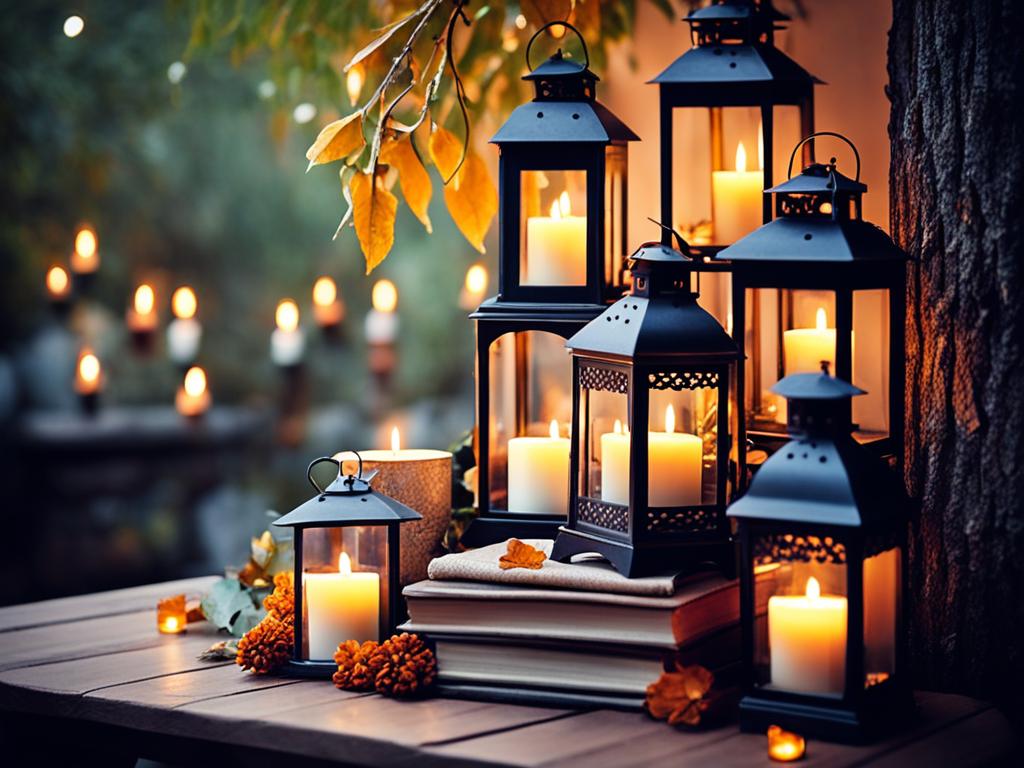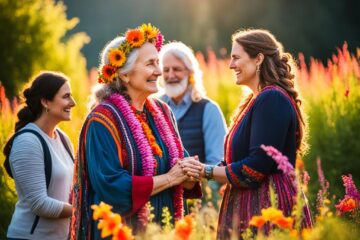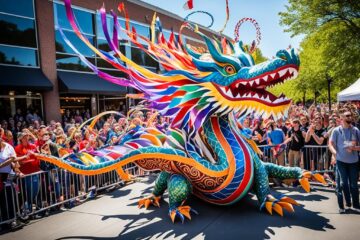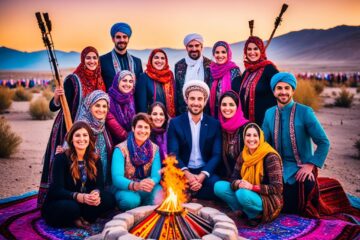When the sun sets, a magical scene unfolds in India. This marks the start of Diwali, the Festival of Lights, a beloved five-day event. The city becomes a dazzling display of candles and lanterns’ warm glows.
Imagine being surrounded by a shimmering ocean of lights on a chilly fall night. Families are eager to welcome the light that beats back the darkness. The play of candle flames and lantern colors creates a truly enchanting atmosphere.
Diwali celebrates the victory of good over evil with passion. It asks us to think about light and dark’s constant struggle in ourselves and the world. The gentle light of candles offers promise, pointing to a future full of love and understanding.
This festival is more than just about lights; it’s about life. Families gather, reflecting on love and the ties that bind them. The air is rich with the scent of cooking and echoes with laughter and happiness.
Diwali is also about starting anew. It reminds us to let go of the past and choose forgiveness. The act of lighting candles and lanterns is a sign to clear our hearts and minds, letting kindness and warmth lead our way.
Enter the Diwali world, where darkness fades, and only love and light stand. Feel the celebration, the joy, and the strong unity that everyone shares during this special time.
Key Takeaways:
- Diwali is a five-day celebration in India that commemorates the victory of good over evil.
- The festival is characterized by the lighting of candles and lanterns, symbolizing the triumph of light over darkness.
- Diwali is a time for families to come together, exchange gifts, and celebrate life.
- The festival encourages self-reflection, forgiveness, and the cultivation of compassion and kindness.
- Diwali is a celebration of unity, joy, and the triumph of love and light.
The Significance of Diwali in Indian Culture
Diwali is a major festival in India, celebrated by many religions. It’s especially meaningful for Hindus. This festival celebrates Lord Rama’s return after defeating the demon Ravana.
Also, the goddess Lakshmi is praised for wealth and fortune during Diwali. People ask for her blessings. They light oil lamps to welcome her into their homes.
Diwali isn’t just about religious rituals. It’s a time for beautiful decorations like rangoli. It’s when lights and diyas shine, signifying hope and good beating evil.
The five days of Diwali mix spiritual practices with happiness. Each day has its special rituals. This makes the celebration rich and fulfilling for those who take part.
Day 1: Dhanteras
Dhanteras is the start of Diwali. It’s about celebrating wealth and buying new things. People believe this brings luck and prosperity.
Day 2: Naraka Chaturdashi
The second day, Naraka Chaturdashi, remembers Lord Krishna’s win over Narakasura. It’s a day of feasts and firecrackers, full of joy and celebration.
Day 3: Diwali
Diwali’s main day celebrates with many lamps, prayers, and exchanges of gifts. Fireworks light up the sky, bringing a joyful feeling everywhere.
Day 4: Govardhan Puja
Govardhan Puja is for Lord Krishna, who protected his village. People make hillocks of cow dung to show thanks for nature’s gifts.
Day 5: Bhai Dooj
Bhai Dooj marks the end, celebrating brothers and sisters. Sisters pray for brothers’ well-being, and brothers give gifts as love symbols.
Diwali is more than religious celebrations. It brings families and communities closer, spreading joy and harmony. This beautiful tradition strengthens bonds and cultural values.
The Five Days of Diwali: Celebration and Rituals
Diwali is the Festival of Lights, celebrated over five days in India. It has deep cultural and religious importance. Each day brings its own unique rituals, making the celebration joyful and vibrant.
Day 1: Dhanteras
Dhanteras is the first day, focusing on wealth worship. People clean and decorate their homes. They also perform special rituals to welcome wealth and prosperity. Buying gold or precious items symbolizes luck.
Day 2: Naraka Chaturdashi
The second day, Naraka Chaturdashi, celebrates Lord Krishna’s victory over Narakasura. In the morning, people take oil baths and pray for Krishna’s protection. Lighting oil lamps and fireworks symbolize the victory of good over evil.
Day 3: Diwali
Diwali, the main day, is about lighting lamps and candles, both inside and outside homes. Decorations and rangoli are put at the entrances. Families gather for Lakshmi puja to seek wealth and prosperity blessings. Colorful fireworks light up the evening.
Day 4: Govardhan Puja
Govardhan Puja, the fourth day, celebrates a mythological event. It tells how Lord Krishna protected his village from rain and floods. People make cow dung mounds, worshiping them as the Govardhan Hill. This day also celebrates the worship of cows.
Day 5: Bhai Dooj
Bhai Dooj, the final day, honors the bond between brothers and sisters. Sisters pray for their brothers’ longevity and prosperity. Brothers, in turn, show their love with gifts. This strengthens their sibling bond.
These days of Diwali bring much joy, spreading positivity and family togetherness. It’s a period for exchanging gifts, sweets, and remembering the victory of light over darkness.
Traditions and Customs during Diwali
Diwali is known as the Festival of Lights in India. It’s a time filled with traditions and customs. These practices celebrate the victory of light over darkness. Let’s look at some important customs and traditions of Diwali.
Rangoli: Vibrant Designs Welcoming Good Fortune
Rangoli designs are a big part of Diwali. They are beautiful, colorful patterns made with powders, rice, or flowers. These designs welcome Lakshmi, the goddess of wealth and prosperity. They make homes look pretty and create a happy feeling during the festival.
Lighting of Diyas: Inviting the Divine Presence
Lighting oil lamps, or diyas, has a big meaning in Diwali. The light from these lamps shows the victory of light over darkness. It is also a way to invite the divine presence into homes. People fill their homes with these lamps to wish for a bright year ahead.
Performing Puja: Seeking Divine Guidance
During Diwali, families come together for puja, or worship. They offer prayers to Goddess Lakshmi and Lord Ganesha. The ceremonies are about asking for abundance, good health, and living in harmony. It’s also a time for people to be grateful and to refresh their spirits.
Exchange of Sweets: Spreading Love and Goodwill
Exchanging sweets is a heartwarming Diwali tradition. It’s an act of spreading love and joy to those close to you. Traditional sweets are prepared and shared as a sign of celebration and unity. This sweet exchange strengthens relationships and brings people together.
Fireworks: Illuminating the Night Sky
Diwali celebrations include fireworks. Colorful bursts and sounds fill the sky, bringing joy. It’s believed that fireworks scare away evil spirits and invite good luck for the new year. The light show adds to the festive mood and is a memorable part of the celebration.
| Traditions and Customs | Description |
|---|---|
| Rangoli | Vibrant and intricate designs made with colored powders or flower petals to welcome Goddess Lakshmi |
| Lighting of Diyas | Oil lamps, called diyas, are lit to symbolize the victory of light over darkness and invite divine blessings |
| Performing Puja | Elaborate rituals and prayers are offered to deities, seeking blessings for abundance and prosperity |
| Exchange of Sweets | Sharing traditional sweets as a gesture of love and goodwill, fostering unity and togetherness |
| Fireworks | Illuminating the night sky with colorful displays, warding off evil spirits and bringing joy |
Diwali Celebrations Across India
Diwali, the festival of lights, is celebrated with joy across India. It marks the victory of light over dark. The celebrations vary, showing India’s many cultures.
In North India, Diwali celebrates Lord Rama’s return. They light diyas to welcome him and wish for his blessings. Everyone comes together to share sweets and gifts.
In West India, Diwali means honoring the goddess Lakshmi. Homes are decorated beautifully. Fireworks fill the sky with colors. There are big gatherings and spiritual music during Diwali.
In South India, Diwali is Naraka Chaturdashi, remembering Lord Krishna’s victory. It starts with an oil bath and new clothes. Then, there’s fun with fireworks. Everyone enjoys making and eating special sweets.
Diwali shows India’s varied traditions and foods. From diyas and fireworks to sweets and gifts, each part of India celebrates in its way. It brings people closer, creating lasting memories of love and togetherness.
The Significance of Candles and Lanterns in Diwali
Candles and lanterns are key in celebrating Diwali. They stand for light overcoming darkness, a core Diwali message. By lighting diyas and candles, we brighten our homes and show the light inside us.
These items mean more than just light. They symbolize good beating evil, knowledge over ignorance, and positivity winning against negativity. Like a single candle’s light, they attract good energy and ward off bad.
Families decorate with these lights, making spaces warm and welcoming. The gentle light reflects our inner goodness. It prompts us to focus on love, compassion, and kindness. This light is also a symbol of hope and prosperity, bringing joy.
“The flickering flame of a candle or the gentle glow of a lantern is a visual representation of the triumph of light over darkness, inspiring us to seek wisdom, enlightenment, and positive transformation.”
The Decorative Splendor of Candles and Lanterns
Candles and lanterns add enchantment to Diwali. They come in beautiful designs and colors, made from various materials. These decorations make homes and streets look festive and joyful.
Not just visually stunning, they also lift our mood. The soft light from candles brings peace and happiness. It encourages togetherness and joy among people.
The Ritual of Lighting Candles and Lanterns
Lighting candles and lanterns is a beloved Diwali tradition. At dusk, families come together to spread light. This is to welcome Lakshmi, the goddess of wealth.
This ritual is sacred. It involves prayer and chants to bless the home. Each lit candle and lantern brings in light and positive vibes, pushing away darkness.

The Exchange of Gifts during Diwali
Exchanging gifts during Diwali is very important. It shows love and goodwill among people. Friends, family, and neighbors share gifts to strengthen their bond.
People often gift special sweets. These treats include Indian sweets like kaju katli or homemade cookies. This sharing of sweets shows the joy of celebrating together.
Decorative items are also popular as gifts. This can be things like candles, rangoli designs, or prayer plates. These gifts not only decorate homes but also symbolize light’s victory over darkness.
Diwali gifts bring people closer. They show love and goodwill. These gifts really help in celebrating unity and forming stronger bonds.
Giving clothes is common during Diwali. People buy new outfits for the big day. This includes sarees and kurta-pajamas. New clothes symbolize fresh starts and good fortune.
Unique and personal gifts are also exchanged. They match the receiver’s likes, such as books or spa vouchers. These presents show deep thought and help build stronger relationships.
Gifting during Diwali is about more than just items. It’s a way to give thanks and spread happiness. This tradition helps unite people and fill the season with joy.
Conclusion
Diwali is an important festival in India. It’s a time of joy, traditions, and gifts. People celebrate the victory of good over evil. This is shown by lighting candles and lanterns, welcoming light into their lives.
This festival shows India’s diverse cultures. Different customs and traditions come to life in various regions and communities. It brings everyone together.
Homes are filled with color and light during Diwali. People make rangoli and light oil lamps. They do this to invite a prosperous and happy new year.
Gifts are exchanged as a sign of caring and to promote unity. Traditional sweets and decorations are popular gifts. They help strengthen bonds with loved ones.
Diwali is all about happiness and unity. It brings people from all walks of life together. It showcases the triumph of light. This symbolizes how goodness always wins.
It’s more than a religious celebration. Diwali also teaches us the value of optimism. Spreading happiness is its core message. It’s about celebrating the good in all of us.




